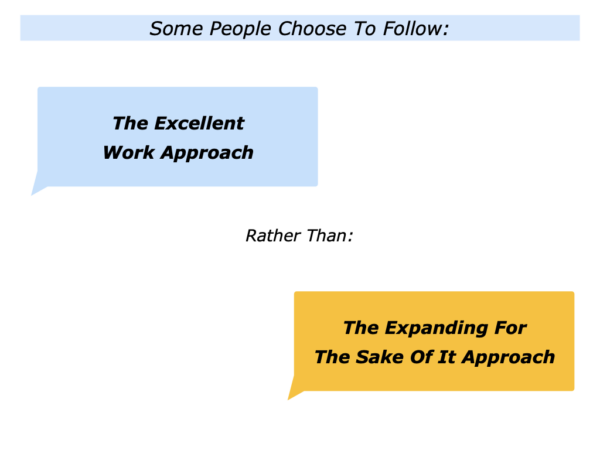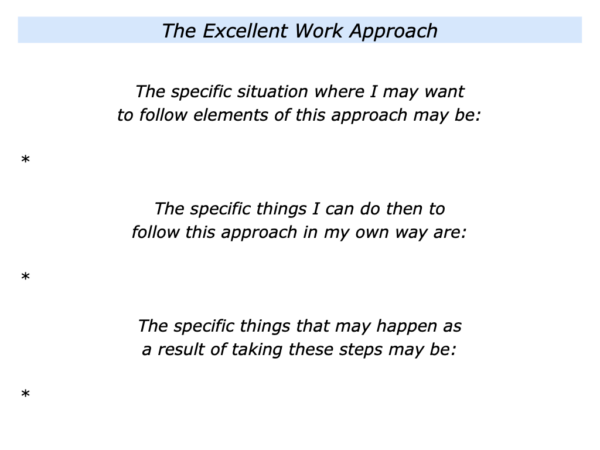
Some people choose to focus on doing certain kinds of excellent work. They take this approach rather than expanding and building an ever-growing organisation or empire.
They believe in delivering high quality standards. Whilst it is possible to expand these across an organisation, this can be challenging. It calls for having people who embody the standards and continually apply these to deliver success.
Such people sometimes choose to pursue their craft by themselves, with a few professional kindred spirits or in a small team. They may find ways to pass on their knowledge, however, so that it reaches many people.
Different people take this route for different reasons. Let’s look at these two main approaches.
The Excellent Work Approach
People who follow this approach often build on their strengths. When working with customers, they have a strong service ethic and do superb work that helps people to achieve success.
They focus on the specific activities where they feel in their element – at ease and yet able to excel. They aim to be effective by following strategies that work and them do their best to deliver excellence.
They sometimes act as positive models for others. They do this by following certain principles and performing superb work. They may also pass on knowledge that helps other people to achieve success.
Such individuals may also develop the savvy to get paid enough to support their chosen lifestyle. They see themselves as professional freelancers who can use their strengths to contribute to certain projects and help their customers to achieve success.
Some small companies take a similar approach. The leader of one such company explained this in the following way.
“We act as strategic advisors and, in some cases, as implementers to specific types of businesses. We have around 20 staff who demonstrate certain qualities.
“They have the right attitude, are customer focused and are also agile in their ability to help the customers to achieve their goals. We have accumulated lots of knowledge but believe in continuing to improve.
“We have looked at growing much bigger by adding many more people to our staff or acquiring another business. But we decided to recruit a few younger staff who had the right attitude.
“This enabled us: a) to help the present staff to play to their strengths and do what they do best; b) to ensure the younger people learned how to continue our ethos of being customer focused.
“We continue to make a good profit and, at the same time, keep anticipating future trends. We keep focusing on how we can help both ourselves and our customers to achieve future success.”
The Expanding Approach
Some people, small companies and organisations consider expanding their operations. They may do this for different reasons.
They may aim to add more market reach, more customers and potentially more profitability.
They may aim to add more products or services to their portfolio to enable them to become more competitive or dominate the market.
They may aim to acquire more people or companies that enable them to centralise certain services and, if applied properly, also add potential synergies.
Such an approach can sound attractive but it also has minuses. People or organisations that follow this path may also encounter the following challenges.
They may spend lots of time trying to manage the process of expanding and, in the process, dilute the quality of their present offering.
They may find it relatively simple to integrate systems but find that people often do not want to be integrated because they want to retain their own identity and autonomy.
They may fail to focus on what they do best and also realise that the benefits of so-called synergies do not appear.
There are expansion models that do work, however, but it is important to do these properly. These include the following approaches.
The Creating A New House Approach
This approach is often used by organisations that aim to keep building on what they are doing well and also shape a successful future. They take the following steps.
They keep maintaining the present ‘house’ – their present way of operating – because this is proving successful and profitable.
They create a new house – a new way of working – by building a successful prototype that will help them to shape a successful future.
They continue to maintain the present house and, when appropriate, move over to the new house. This becomes the new way of doing things in the organisation.
The Coexistence Approach
Some companies follow the coexistence approach when they acquire businesses. Whilst other big companies take the complete take over approach and swallow up the other business, some companies aim to get the best of both worlds. They take the following steps.
They integrate some generic systems and functions.
They give the acquired business autonomy – within certain parameters – to build on their strengths.
They make clear contracts with the acquired business about the outcomes they will deliver and their best contribution to the big company.
Companies that take the coexistence approach may sometimes encounter challenges. They then try to find, as far as possible, win-win solutions that produce benefits for all the stakeholders.
The Collaboration Approach
Some organisations find ways to channel people’s complementary strengths to achieve success. Such organisations sometimes take they following approach.
They have a central person who acts as a good coordinator. Such a person has the ability to look across the various units and find opportunities for orchestrating people’s strengths.
They communicate a compelling goal, show the benefits and, where appropriate, make clear contracts about people’s contributions towards achieving the goal.
They coordinate people’s strengths enable them to do superb work and find solutions to challenges on the way towards achieving the compelling goal.
Organisations that take this approach recognise that it is vital to appoint a central coordinator. This person looks across the various units and channels people’s strengths to tackle challenges or achieve compelling goals.
There are many ways to do fine work. Some people and teams choose to focus on what they do best. They continue to deliver excellence and earn enough money to follow their chosen lifestyle.
Some follow the philosophy embodied in the well-known anecdote about the contented fisherman. Some follow elements of this philosophy but also create enough financial runway to manage unexpected events in the future. Here is one version of the old story.
The Contented Fisherman
The rich industrialist from the North was horrified to find the Southern fisherman lying lazily beside his boat, smoking a pipe.”
Why aren’t you out fishing?” said the industrialist.
“Because I have caught enough fish for the day,” said the fisherman.
“Why don’t you catch some more?”
“What would I do with it?”
“You could earn more money” was the reply. “With that you could have a motor fixed to your boat and go into deeper waters and catch more fish.
Then you would make enough to buy nylon nets.
“These would bring you more fish and more money. Soon you would have enough money to own two boats … maybe even a fleet of boats. Then you would be a rich man like me.”
“What would I do then?”
“Then you could really enjoy life.”
“What do you think I am doing right now?”
Let’s return to your own work. Can you think of a situation where you may want to follow the excellent work approach and support your chosen lifestyle?
There may be times when you want to add elements of the expanding approach – but not for the sake of it. If appropriate, how can you do this in your own way?
If you wish, try tackling the exercise on this theme. This invites you to complete the following sentences.







Leave a Reply